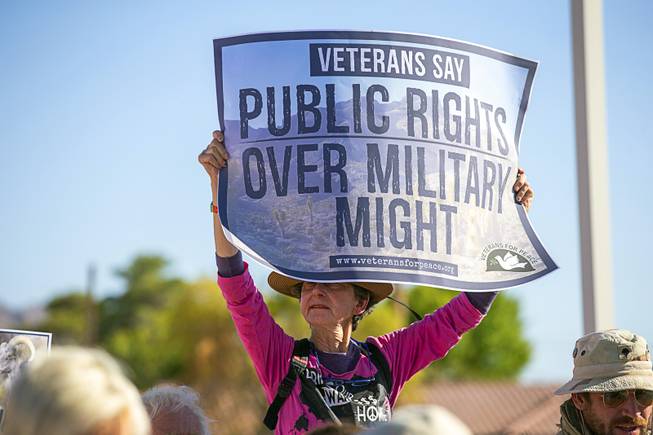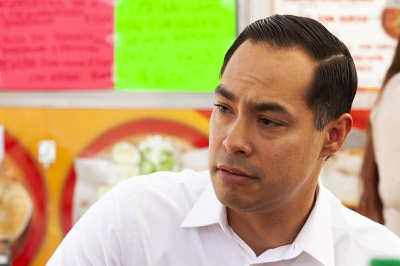
Susan Witka of San Francisco holds a sign during a protest at the main entrance to Nellis Air Force Base Thursday, Oct. 3, 2019. Veterans For Peace, Code Pink and other groups are opposed to a plan that would expand the Nevada Test and Training Range into the Desert National Wildlife Refuge.
Tuesday, Oct. 8, 2019 | 2 a.m.
View more of the Sun's opinion section
No matter where I have been in my presidential campaign, including Nevada, Americans are passionate about protecting their public lands.
The Desert National Wildlife Refuge, just north of Las Vegas, is a gem within our National Wildlife Refuge System. As the largest refuge in the Lower 48 states, it encompasses an irreplaceable cultural landscape for the Southern Paiute people and protects 1.6 million acres of contiguous high-quality habitat for the desert bighorn sheep, Nevada’s state animal.
Nearby, the U.S. Air Force manages almost 3 million acres of land at the Nevada Test and Training Range. Part of Nellis Air Force Base, this is one of the world’s largest and most pre-eminent ranges for aerial training and mission exercises. For comparison, the range is almost as big as the state of Connecticut.
However, the Air Force is proposing to expand the range by taking over approximately 300,000 acres of the Desert National Wildlife Refuge. These actions will have devastating consequences for the refuge — for the people who call it a sacred landscape and for the wildlife it protects.
The Moapa Band of Southern Paiute Indians is resisting the proposed expansion, calling the refuge “central to the lives of Native American tribes.” The bighorn sheep that are native to the refuge are sacred to the Moapa people, and the land is frequently used for traditional and ceremonial purposes that are crucial to the continuity of native culture and religion.
For generations, indigenous communities have been treated as second-class citizens rather than sovereign tribal nations. The federal government has repeatedly failed to honor treaty obligations, respect unique government-to-government relationships, and has allowed exploitation of sacred land. As secretary of housing and urban development, I visited and worked with indigenous communities and tribal nations across the country, hearing directly from native peoples about their experiences and challenges. These conversations were some of the most impactful of my entire career.
In August, I attended the Frank LaMere Native American Presidential Forum, where I discussed the need to partner with tribes for a fairer and more prosperous future, ensure indigenous voices are at the decision-making table and respect native communities and the lands they hold sacred. To protect and respect indigenous communities, we must modernize and codify tribal consultation requirements to ensure federal agencies have a meaningful and responsive process to solicit input from indigenous communities when pursuing policies that affect them and ensure that indigenous communities have judicial recourse when meaningful consultation is not conducted. We also need to elevate these issues to the highest levels of government, which is why we must reinstitute the annual White House Tribal Nations Conference, create a White House Council on Indigenous Communities to coordinate interagency Native American policy and establish well-resourced Tribal Advisory Committees within each Cabinet-level federal agency.
It’s not just Native American communities that oppose the takeover of the Desert Refuge. More than 32,000 people submitted comments to the Air Force in opposition to the expansion of Nellis’ bombing range. Earlier this year, the Nevada Legislature passed nearly unanimously the bipartisan Assembly Joint Resolution 2, opposing any takeover of the Desert Refuge. The Las Vegas Sun recently editorialized against the bombing range expansion.
The Veterans for Peace have taken a strong stance in support of the refuge. And conservation groups like Friends of Nevada Wilderness, the Sierra Club and the Center for Biological Diversity have been sounding the alarm about this issue and mobilizing their members to engage with Congress. Standing with this broad coalition of stakeholders also aligns with the goals enunciated in my Protecting Animals and Wildlife (PAW) Plan. A central feature of this plan is to protect at least 30% of America’s land by 2030, which scientists say is critical to allowing large reserves of biodiversity to adapt to a changing climate.
I’m proud to stand with the Moapa Paiute Tribe, the Nevada Legislature and the thousands of Nevadans who have spoken out in opposing the Air Force’s plan to take over part of Desert National Wildlife Refuge. Nevadans, including the indigenous communities within the state, deserve a seat at the table. To ignore their opposition and use their land for bombing practice is disrespectful to those communities and destroys the land and wildlife sacred to them.
Julián Castro, a Democratic presidential candidate, served as secretary of housing and urban development from 2014 to 2017 and is a former mayor of San Antonio.

